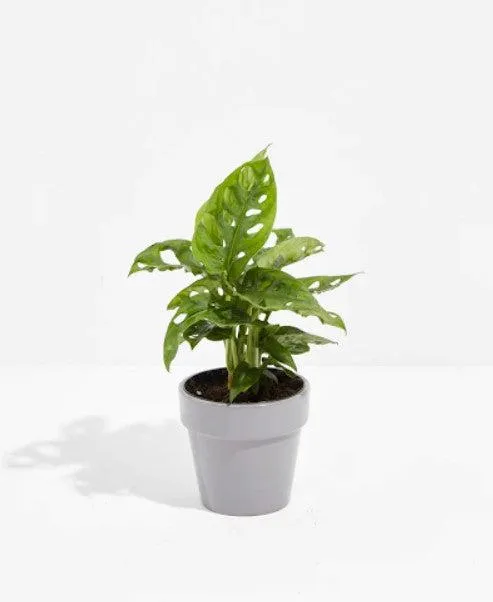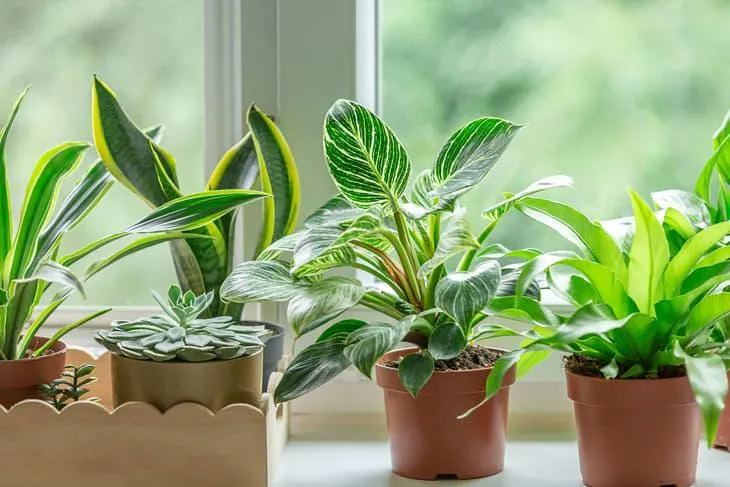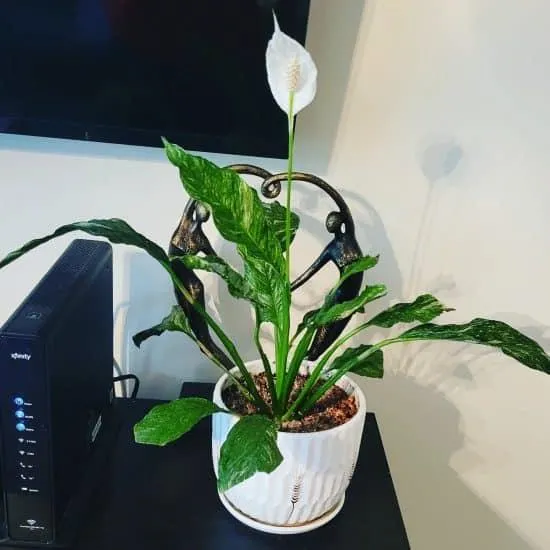Everything You Need to Know About Variegated Indoor Plants
Variegated plants have unique and stunning foliage that makes them popular houseplants. As an outdoor gardener and avid indoor plant parent, I’ve learned a lot about these divas over the years. In this article, I’ll cover the top questions people ask about variegated indoor plants and provide tips to keep them looking their best.
What is a variegated plant?
A variegated plant is one with foliage that has splotches or streaks of a different color than the main leaf color, usually white, yellow or pink. The variegation gives the leaves aunique pattern that makes these plants stand out visually from regular green foliage. Variegation occurs naturally due to a genetic mutation or can be artificially induced through grafts and cuttings.
Why are variegated plants popular houseplants?
- Stunning foliage: Their elegant multicolored leaves create a striking visual effect that stands out from ordinary green plants.
- Low light tolerance: Despite their good looks, many variegated plants thrive in low and medium indoor light conditions where green plants struggle.
- Unique patterns: No two variegated plants have exactly the same leaf pattern, so each one feels special and like an individual work of art.
From my experience, their eye-catching appeal makes variegated plants a showstopper addition to any indoor space. Guests often comment on how amazing my variegated monstera looks in my living room!
What types of plants commonly have variegation?
Some of the most popular variegated indoor plants include:
- Monstera: They’re one of the trendiest houseplants right now thanks to their large perforated leaves. Variegated monstera has splashy white stripes.
- Philodendron: Types like birkin and moonlight have creamy variegated leaves with dark veins.
- Pothos: Golden, marble queen and neon pothos feature striking yellow, white or pink variegation.
- Chinese evergreen: They come in many variegated forms with white or yellow splotches.
- Peperomia: Variegated varieties of peperomia have multicolored foliage perfect for low-light areas.
These are just some of the most common variegated indoor plants. New cultivars are constantly being developed and introduced to houseplant collections.
Will variegated plants grow back variegation if it’s lost?
This is one of the main concerns people have about variegated plants. Sometimes, a cutting or leaf may lose its variegation and revert back to solid green. The good news is variegation is usually stable and will not disappear from the whole plant. However, there is always a small chance a variegated plant may fully or partially revert.

To maintain variegation, make sure the growing conditions like light and nutrients meet the plant’s needs. Some variegation loss may be due to environmental stressors or insufficient care. As long as the mother plant stays variegated, any cuttings or propagations taken from it should also retain the leaf pattern. But in nature, variegation can sometimes be unpredictable.
How do you care for variegated indoor plants?
While variegated plants make beautiful decorations, they require some extra TLC compared to regular houseplants:
- Light: They need higher light levels close to a sunny window to prevent losing variegation and encourage new variegated growth. Low light will cause blotchy reversion.
- Water: Water carefully and allow the soil to dry slightly between waterings. Overwatering can cause melted, mushy leaves.
- Fertilizer: Fertilize regularly during the growing season with a balanced houseplant food. Variegated plants need extra nutrients to maintain their patterns.
- Pruning: Remove any fully reverted green leaves or stems to promote more colorfully variegated growth.
Paying close attention to light, water and nutrients is key for variegated indoor plant success. Stick to these best care practices and your plant babies will stay in top colorful form.
Are variegated plants harder to care for than green plants?
On the surface, variegated plants seem harder due to their pickier needs. However, once you get the hang of their care, it’s really not that much more effort than regular foliage plants.
The main thing is providing adequate, bright light. As long as their light conditions are met, variegated plants tend to be quite resilient. Water and fertilizer requirements don’t differ much either. The tradeoff is you get a showstopping centerpiece for your home that turns more heads than a plain green plant.
So while variegated plants may need slightly more attention at first, their rewards in beauty and visual interest make them absolutely worth the minimal extra work in my opinion. Their prettiness motivates me to fuss over them a tad more than my green pals.

Will variegated cuttings grow true to the mother plant?
When propagating variegated plants through stem or leaf cuttings, there is usually a high chance the new growth will maintain the parent’s variegation patterns. This makes variegated plants very suitable for increasing your houseplant collection through propagation.
However, there is always a slight risk of reversion. To keep this from happening, be sure to take cuttings only from healthy, actively growing areas of the mother plant showing strong variegation. Provide the proper growing conditions like bright light and humidity to encourage new variegated growth.
In most cases, variegated cuttings will come true. But you may see the occasional fully green sports mutation. Simply remove any non-variegated growth to encourage the variegated pattern.
Can variegated plants be passed down as heirlooms?
Many collectors and plant fans enjoy variegated plants not just for their decor value, but as living art or heirlooms to hand down within families. When well-cared for over generations, variegated plants truly become priceless collectibles.
As long as variegation is maintained throughpropagation or cuttings taken from the mother plant, these plants can absolutely be passed down as family treasures. Some beloved variegated specimens have been carefully tended for decades and remain vibrant, lifelong centerpieces of homes.
Adding variegated plants to your collection lets you connect with nature, beauty, history and relationships all at once. The memories and legacy created are far more valuable than any monetary worth.

I hope this guide has helped answer your questions about variegated indoor plants! Feel free to reach out if you need any other care or plant variety recommendations. Happy planting!
Factors to Consider When Choosing a Variegated Indoor Plant
| Plant | Light Needs | Water | Size | Care Level |
|---|---|---|---|---|
| Peperomia | Bright indirect light | Allow soil to dry slightly between waterings | Small to medium | Easy |
| Pothos | Low to medium light | Water when top inch of soil is dry | Trailing vine, can grow very long | Very easy |
| Philodendron | Medium to bright indirect light | Water when top inch of soil feels dry | Can vine or climb, size varies by variety | Easy |
| Chinese Evergreen | Bright indirect light | Allow soil to dry slightly between waterings | Medium sized shrub | Easy |
| Monstera | Bright indirect light | Water when top inch of soil is dry | Can vine or climb, size varies by maturity | Easy to medium |
FAQ
-
What types of plants are variegated indoor plants?
Variegated indoor plants come in lots of different kinds. Some common ones are Chinese evergreen, spider plant, pothos, philodendron, and marble queen. These plants got streaks or spots of white, yellow or cream on their leaves which makes them stand out from regular green plants.
-
How do you care for a variegated indoor plant?
Mostly you care for a variegated plant very similarly to other houseplants. Give them good light but not direct sun, water when the soil becomes dry, and feed them occasionally during the growing season. The only different thing is you gotta be careful not to get too much sun on the white or yellow parts since they can burn. Other than that, they’re basically low maintenance plants.
-
Why do some indoor plants have variegated leaves?
The exact cause of leaf variegation isn’t totally clear. However, it seems genetics are involved – some plant species just naturally develop differently colored patterns. The white or yellow parts can’t produce chlorophyll like green parts, so they stay that color. Many gardeners and plant collectors like the unusual appearance. Yet it’s uncertain whether variegation benefits the plant or not.
-
Are solid green plants better than variegated ones?
Green plants and variegated plants each have pros and cons. Green foliage allows for maximum photosynthesis which is sort of important. But variegated leaves look pretty awesome in a home! On the other hand, the white sections can’t produce energy and struggle more in low light. Perhaps the solid green varieties have an advantage for thriving, yet variegated kinds bring much needed visual interest. It’s a tough call which is superior!
-
How long do variegated houseplants typically last?
The lifespan of a variegated plant depends a lot on care and environment. With ideal growing conditions – good light, appropriate watering, occasional fertilizer – some varieties may last for years. However, the white or yellow portions have decreased durability and are prone to burn, rot, or revert back to solid green over time. Usually variegated indoor plants won’t endure as long as their non-variegated cousins. But with luck and TLC, a beautiful variegated plant might surprise us by living impressively long!

So in summary, while variegated indoor plants need extra precautions due to their unusual foliage, their unique leaf patterns can seriously spice up a home’s décor. Whether long-lasting or not, their good looks are well worth the slight extra bother of keeping them happy and healthy. With diligent care, these funky plants can reward us with beauty for many months or maybe even years to come. Who knows – perhaps you’ll become so fond of your variegated leaf friends that you’ll start your own impressive collection!
